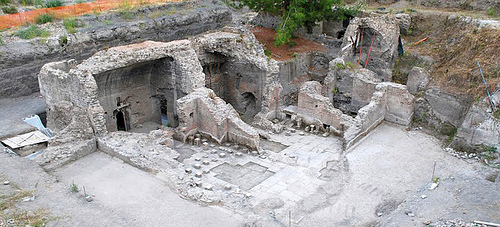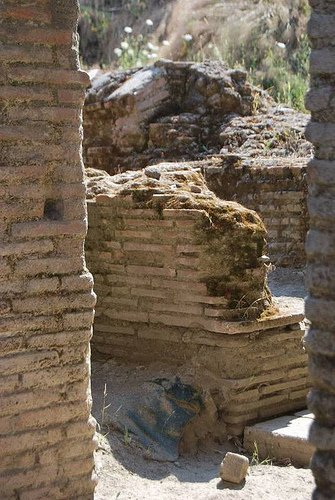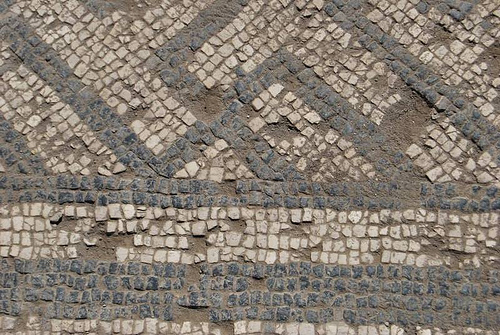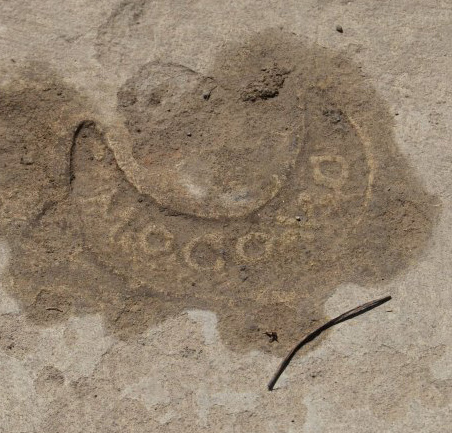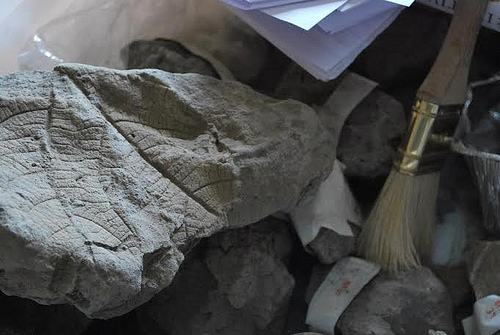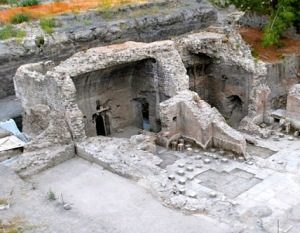
Since their discoveries, the ancient Roman cities of Pompeii and Herculaneum, those hapless victims of the Mt. Vesuvius eruptions of AD 79, have captured the public’s imagination and have thus commanded the attention of both the academic community and the general public. The recent exhibition at the British Museum that highlighted Pompeii and Herculaneum, coupled with the release of the major motion picture, Pompeii, have popularized the ancient cities all the more. There is, however, another story along the northern slopes of Vesuvius that tells of a people who lived and died on the “other side” of the better-known setting. Archaeologists have recently uncovered evidence of the people who lived and died on what has been termed “the dark side of Vesuvius”, the northern slopes of the volcano and the adjoining ancient territories of Nola and Neapolis. It is a story that may encompass not just the well-known AD 79 eruption, but multiple past eruptions as well. Known as the Apolline Project, teams of archaeologists, other scientists, students and volunteers have been slowly piecing together what remains of the ancient settlements that survived and were dramatically affected by these cataclysms.
The Northern Territories
The fertile landscape around Mount Vesuvius has always made it an idyllic and desirable setting for human occupation. Rich in minerals, rivers, and hot springs, this fertile volcanic landscape is as inviting as it is precarious, yielding a wealth of foodstuffs such as olives, hazelnuts, shellfish, figs, and grapes, to name a few. Archaeologists have now discovered evidence of ancient ploughed fields, orchards, vineyards, and Roman centuriation grids, demonstrating that in antiquity the region was thoroughly exploited through the cultivation of a wide variety of crops, as it is today. Considering this abundance and variety of natural resources, from foodstuffs and fuel to natural building materials, the northern territories of Nola and Neapolis were well placed to become centers of mass industrial activity. Ancient literary sources testify to this; for example, Strabo described the area as “dotted all around with cities, buildings, and plantations, so thoroughly intertwined that it resembles closely a metropolis”. Wine, in particular, was a valuable export for this prosperous region, supporting trade connections as far as Britannia and India. Understanding the exact nature of the communications and exchange processes within this region both before and after AD 79 has become the principal pursuit of the Project, which seeks to understand not only the people who lived during these times, but the nature of the economic and industrial landscape as well.
But the archaeologists face a challenge not uncommon in the field. The region of Campania, which today contains the traces of this area, has been intensively settled and urbanized and as a result, only a small percentage of its vast history has been brought to light. It presents a real obstacle to archaeologists who are attempting to reconstruct an image of the ancient landscape and its settlements. Nevertheless, the accessible sites lying on the northern slope of Vesuvius have provided them with a window with long spans of occupation featuring multiple stages of post-eruption recovery and repopulation that provide clear, rich stratigraphies, allowing for the creation of extended chronologies and timelines.
The Finds at Pollena Trocchia
Key to the efforts on the northern slope has been the discovery of a Roman bath and villa site located in the town of Pollena Trocchia. Since 2005, most of the baths have been unearthed, revealing evidence to suggest that it was part of a larger villa complex now buried underneath an adjacent modern block of flats. The discovery of the volcanic material deposited by the AD 79 eruption indicated that the villa complex, or the baths at least, were built in the years after the eruption. As a result, the insight that the finds have provided in terms of both the inhabitants and their impetus to settle there has been extraordinary. The discovery of a brick stamp imprinted onto a tile lining the bath’s hypocaust, for example, shows the distinct mark of the Domitii brothers, a prosperous family from Rome who produced this stamp between AD 75 and AD 95. This connection with Rome, along with the many lavish finds, suggests that the inhabitants of this site were very affluent and settled there soon after the eruption, perhaps tempted by the fertile earth left by the volcano.
Moreover, the rich data from the site at Pollena Trocchia obtained through charcoal analysis of carbonized plant remains has revealed the exact species of vegetation and offers insight into how they were cultivated to shape the Roman landscape. For example, evidence of chestnut (a known construction timber used by the Romans) suggests that the late antique woodland on the north slope may have been partially and purposefully composed of chestnut trees. In fact, the plethora of woodland that blanketed Mount Vesuvius in Roman times was also required in vast quantities for fueling industries such as pottery-making and iron-smithing. It also played a more domestic role in cooking and in the heating of Roman baths. By identifying evidence of activities that would have incorporated wood, as well as the remains of wood itself, archaeologists and palaeobotanists alike are investigating the transportation and management of ancient forests, and whether the woodland of Vesuvius was enough to satisfy the enormous demand for timber.
The researchers have found that not all archaeological finds, however, are as easily comprehensible. A few years ago, the remains of two children were discovered buried in two small amphorae. Amphorae are large pottery vessels that were usually used for transporting wine and other foodstuffs, but they were also occasionally used for infant burials. Thus far, the tale surrounding these children, possibly twins, remains a mystery.
The occupation of this site may have ended the way it began, with a volcanic eruption. This eruption struck on November 6th, AD 472, the site itself being destroyed by lahars. The lahars were produced by the eruption, creating an atmospheric disturbance that caused severe downpours of rain, which then flowed rapidly down the mountainsides, picking up literally tons of ash and mud on their way. As devastating as this event was, the stratigraphy it left behind has been indispensable to the archaeological research.
_______________________________________
Overview of the excavated remains of the Pollena Trocchia bath complex. © Girolamo F. De Simone.
___________________________________________________
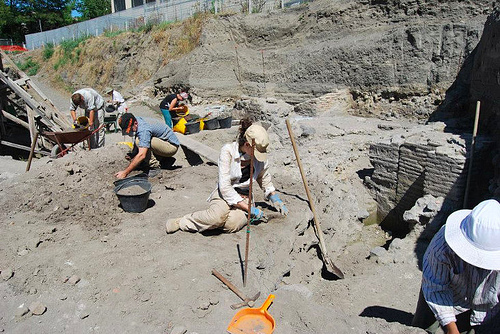 Excavating volcanic ash under the heat of the midday sun is no easy feat, but these archaeologists are determined to make a discovery. © Girolamo F. De Simone.
Excavating volcanic ash under the heat of the midday sun is no easy feat, but these archaeologists are determined to make a discovery. © Girolamo F. De Simone.
____________________________________
Although the volcano leveled these baths, many walls are still so high that it remains a walk-in complex. © Girolamo F. De Simone.
______________________________________
Stunning preservation of mosaic floors bring the baths to life. © Girolamo F. De Simone.
________________________________________
A splash of water reveals the hidden maker’s mark of the Domitii Brothers on this flooring brick stamp. © Girolamo F. De Simone.
__________________________________________
The imprints of carbonized vegetation have led palaeobotanists to determine exactly what trees and plants the Roman inhabitants were using in their daily lives. © Girolamo F. De Simone.
____________________________________
Pollena Trocchia is not the only site that has shed light on the area. For example, the grand villa complex at Somma Vesuviana boasts a long and mysterious history, with speculation about its ownership and function. Around the time of its discovery, it was thought to have been owned by the Emperor Augustus himself. Originally a luxurious stately home, the function of the building changed after the AD 79 eruption, and there are strong indications that it might have been an industrial center for the mass production of wine. During excavations by the University of Tokyo, a plethora of Dionysiac imagery and motifs have been found throughout the structure, strongly conveying Dionysus, the Roman God of wine and merriment, as the patron diety. One beautiful, well-preserved, marble statue particularly evokes this: it features the god holding a panther cub, a very rare pose. Due to the size and discoveries made at this site, it is well known within the field of Roman archaeology. It is this scale of attention that Apolline Project researchers hope to achieve for the Pollena excavations. In addition, the Villa of Lauro, also in this region, has had its fair share of archaeological attention. Abandoned after the AD 472 eruption, these Roman baths are thought to have belonged to a larger villa complex, much like those at Pollena Trocchia. Thanks to an extraordinary fresco found in Lancellotti Castle nearby, researchers have deduced that much of this villa was removed to construct the church of San Giovanni del Palco. The Villa of Laura baths are most noted for their decoration. Also known as ‘The Blue Baths’, the walls, flooring, and stone furnishings are studded with bold blue tesserae, shells and other decorative materials. The surviving mosaics depict detailed scenes involving various birds, plant life, and deer hunting.
Combining secondary sources such as maps and literary accounts with results of the actual excavations, the Project has constructed local archaeological maps of the area around Nola and Neapolis, thus giving back to the modern day residents a sense of their history and identity. Project staff have also engaged with local landowners and enthusiasts to give the community an active role in the search for their heritage, a quest that is expected to continue for generations.
For more information on the work of the Apolline Project and how to participate, go to the website at http://www.apollineproject.org/.
Interested readers may also contact the project’s director, Girolamo Ferdinando De Simone at [email protected].
_______________________________________________
_______________________________________________
Read about the most fascinating discoveries with a premium subscription to Popular Archaeology Magazine. Find out what Popular Archaeology Magazine is all about.

